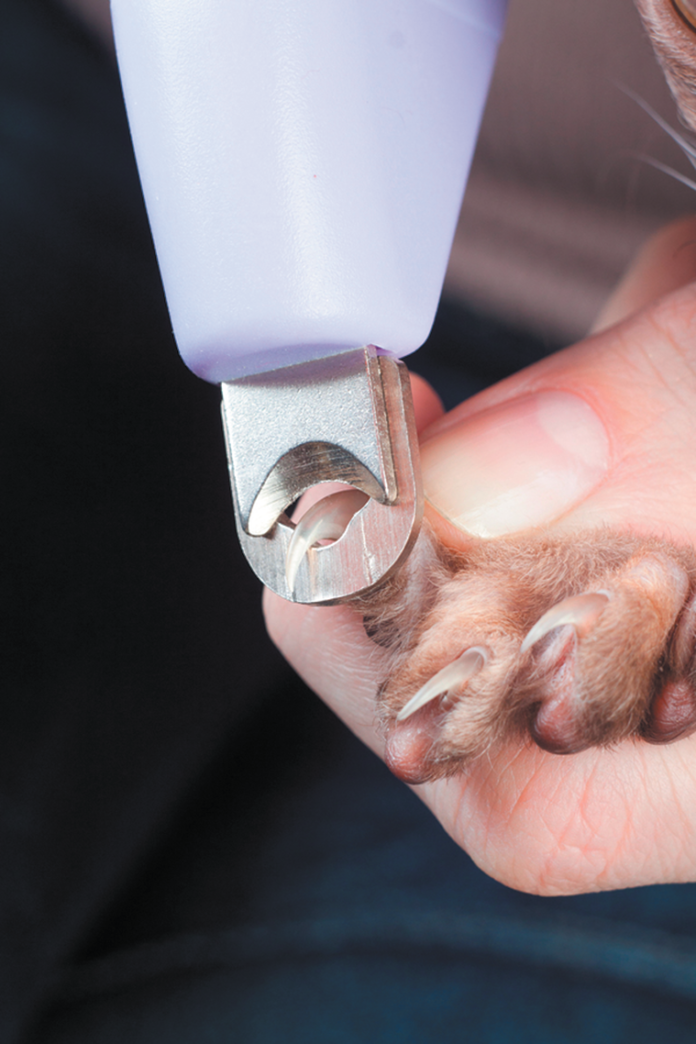Regularly trimming your cat’s nails isn’t just important for your furniture, or for you when the cat comes to knead on your lap. It also reduces the chance of a broken claw and ensuing pain if the cat’s nail gets caught in something like plush carpet or a soft piece of wood.
The ASPCA recommends trimming a cat’s nails every 10 days to 2 weeks; the Humane Society of the United States, “every few weeks.” If you split the difference and come up with an average somewhere in the neighborhood of three to four times every 2 months, you and your cat should be in good shape.
Toolbox
You can use a special pair of scissors that hold a cat’s nail in place, clippers that resemble pliers, or those with a sliding blade that acts like a guillotine. Some people even manage to get away with clippers meant for people. Whatever you use, just make sure the blade remains sharp, as a dull blade can prove painful to your pet and can cause a nail to split and even bleed. If you need to replace a clipper that has a dull blade, it’s worth the money to keep your cat comfortable.
Just as important: never clip more than the sharp tip at the very end of the nail. That’s all you need to trim away to keep the cat, you, and your furniture safe. If you go any further, you risk cutting the claw’s sensitive quick, filled with nerves and blood vessels. That could cause a lot of pain and potential bleeding.
Getting your cat to buy in
It’s always good to start when your cat is young so it’s not something she has to adjust to later. If your cat is an adult and you have never clipped her nails, don’t even start by trying to clip them. Merely touch and massage one and then another of your pet’s paws, pushing gently on the tops and bottoms to get the claws to extend. You can do this with your pet held firmly on your lap, in the crook of your arm, or on a counter or chair that you kneel beside — whichever you think will work best for you and your particular pet. Reward her with soft praise and perhaps a wonderful food treat if she complies. If her tail starts swishing or her ears flatten or she jumps away, let it go and try again another day. Trying to force a cat to do something that makes her uncomfortable will end in tears — yours.
Once your cat becomes comfortable with you manipulating her paws, press gently on the tops and bottoms of each for actual clipping, one at a time, to get her nails to extend. If she gets upset after she extends one claw, or none, let it go. The aim isn’t to “win.” It’s to get your cat to learn to collaborate, to be a partner in this exercise without undue consternation. If it takes a couple more weeks than you anticipated, so what?
Once you think the time is right, clip the tip of one nail, and one nail only. Another day, try a second nail. You can work up to several nails, or even a whole paw’s worth, over time.
Never attempt to trim a cat’s nail, or nails, when she is feeling agitated or when you are upset. Certainly never show anger because she doesn’t comply. She has no idea why you’re doing what you’re doing other than to get in her face. The atmosphere has to be calm and mellow to insure her fullest cooperation.
Many cat owners trim the front claws only. But if your pet’s back claws hurt you as she jumps on and off your lap, consider doing the back ones, too. Never start with the rear claws, though, especially when the cat is learning to adjust to the process of nail trimming. The Humane Society points out the “most cats fuss more about having their rear claws clipped.”
Note: You can always ask your veterinarian, or the veterinarian’s technician, for a demonstration. There are also some good demonstrations on YouTube, for instance, “Vet Tutorial: How to Safely Trim a Cat’s Nails” and “How to Trim Your Cat’s Nails,” both given by veterinarians.




